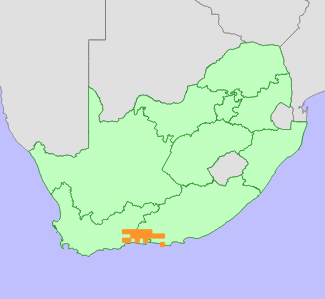|
Scientific Name | Leucadendron pubibracteolatum I.Williams |
Higher Classification | Dicotyledons |
Family | PROTEACEAE |
Common Names | Purple-leaf Conebush (e) |
National Status |
Status and Criteria | Near Threatened B1ab(iii,iv,v)+2ab(iii,iv,v) |
Assessment Date | 2019/08/12 |
Assessor(s) | A.G. Rebelo, H. Mtshali & L. von Staden |
Justification | Leucadendron pubibracteolatum is endemic to the mountains of the Eastern Cape and Western Cape provinces in South Africa. It has an extent of occurrence (EOO) of 12463 km², and an area of occupancy (AOO) of 384 km². Subpopulations are severely fragmented as more than 50% of the population is found in small and isolated subpopulations. Unexplained subpopulation decline has also been observed, but it is not certain whether this is natural post-fire decline or not. Even though between one-third and half of subpopulations are conserved, precaution suggests that this species needs careful monitoring. It therefore qualifies for listing as Near Threatened under criterion B. |
Distribution |
Endemism | South African endemic |
Provincial distribution | Eastern Cape, Western Cape |
Range | This species is found in Eastern Swartberg and Outeniqua to Baviaanskloof mountains, in the Eastern Cape and Western Cape provinces of South Africa. |
Habitat and Ecology |
Major system | Terrestrial |
Major habitats | Kango Conglomerate Fynbos, Kouga Grassy Sandstone Fynbos, Kouga Sandstone Fynbos, South Kammanassie Sandstone Fynbos, North Kammanassie Sandstone Fynbos, South Swartberg Sandstone Fynbos, North Swartberg Sandstone Fynbos, Tsitsikamma Sandstone Fynbos, South Outeniqua Sandstone Fynbos, North Outeniqua Sandstone Fynbos |
Description | Plants grow in dry, stony sandstone slopes, 300-1000 m. Mature individuals are killed by fires, and only seeds survive. Seeds are released after ripening, and collected by rodents and stored in underground caches, where they are protected from fires. It is dioecious, with insect-pollinated male and female flowers occurring on separate plants. |
Threats |
| Although more than half of the species' habitat is in protected areas, the remaining habitat outside these areas is infested by alien invasive plants. There have been unexplained population declines and recruitment failure observed, which may have been due to drying up of the south facing slopes but may also have been linked to fire cycle responses. Close monitoring of this species is required to determine if an overall decline is taking place. |
Population |
There are 53 subpopulations known but these almost all comprise of small numbers of isolated plants, only 15 have densities of more than 100 plants. More than 50% of the subpopulations are small in size and naturally fragmented from each other. The population trend is currently unknown.
|
Population trend | Unknown |
Conservation |
| It is conserved in the Swartberg East, Kammanassie, Baviaanskloof, Kouga, Guerna, Bergplaats and Doringrivier Nature Reserves, and in Soetkraal National Park. |
Assessment History |
Taxon assessed |
Status and Criteria |
Citation/Red List version | | Leucadendron pubibracteolatum I.Williams | NT B1ac(iv)+2ac(iv) | Raimondo et al. (2009) | | Leucadendron pubibracteolatum I.Williams | Not Threatened | Hilton-Taylor (1996) | |
Bibliography |
Goldblatt, P. and Manning, J.C. 2000. Cape Plants: A conspectus of the Cape Flora of South Africa. Strelitzia 9. National Botanical Institute, Cape Town.
Hilton-Taylor, C. 1996. Red data list of southern African plants. Strelitzia 4. South African National Botanical Institute, Pretoria.
Raimondo, D., von Staden, L., Foden, W., Victor, J.E., Helme, N.A., Turner, R.C., Kamundi, D.A. and Manyama, P.A. 2009. Red List of South African Plants. Strelitzia 25. South African National Biodiversity Institute, Pretoria.
Rebelo, T. 2001. Sasol Proteas: A field guide to the proteas of southern Africa. (2nd ed.). Fernwood Press, Vlaeberg, Cape Town.
|
Citation |
| Rebelo, A.G., Mtshali, H. & von Staden, L. 2019. Leucadendron pubibracteolatum I.Williams. National Assessment: Red List of South African Plants version 2024.1. Accessed on 2025/11/17 |
 Comment on this assessment
Comment on this assessment

